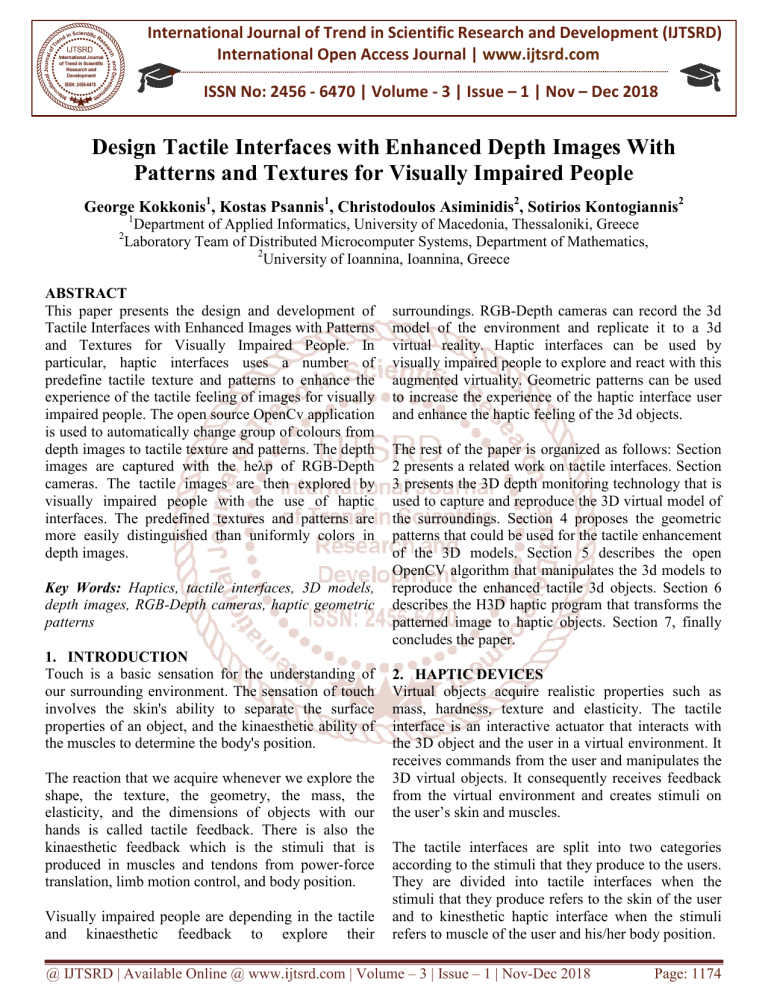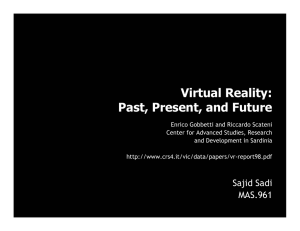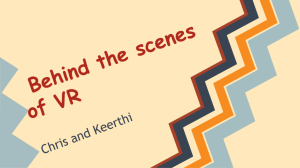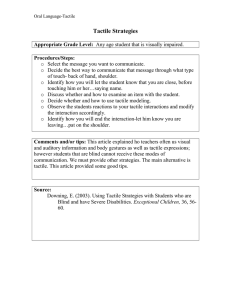
International Journal of Trend in Scientific Research and Development (IJTSRD)
International Open Access Journal | www.ijtsrd.com
ISSN No: 2456 - 6470 | Volume - 3 | Issue – 1 | Nov – Dec 2018
Design Tactile
tile Interfaces with
ith Enhanced Depth Images With
Patterns and
nd Textures for
or Visually Impaired People
George Kokkonis1, Kostas Psannis1, Christodoulos Asiminidis2, Sotirios Kontogiannis2
1
2
Department of Applied Inf
Informatics, University of Macedonia, Thessaloniki,
Thessaloniki Greece
Laboratory Team of Distributed Microcomputer Systems, Department of Mathematics,
Mathematics
2
University
niversity of Ioannina, Ioannina, Greece
ABSTRACT
This paper presents the design and development of
Tactile Interfaces with Enhanced
ed Images with Patterns
and Textures for Visually Impaired People. In
particular, haptic interfaces uses a number of
predefine tactile texture and patterns to enhance the
experience of the tactile feeling of images for visually
impaired people. The open source
urce OpenCv application
is used to automatically change group of colours from
depth images to tactile texture and patterns. The depth
images are captured with the heλp
λp of RGB
RGB-Depth
cameras. The tactile images are then explored by
visually impaired people with
ith the use of haptic
interfaces. The predefined textures and patterns are
more easily distinguished than uniformly colors in
depth images.
Key Words: Haptics, tactile interfaces, 3D models,
depth images, RGB-Depth
Depth cameras, haptic geometric
patterns
1. INTRODUCTION
Touch is a basic sensation for the understanding of
our surrounding environment. The sensation of touch
involves the skin's ability to separate the surface
properties of an object, and the kinaesthetic ability of
the muscles to determine the body's position.
The reaction that we acquire whenever we explore the
shape, the texture, the geometry, the mass, the
elasticity, and the dimensions of objects with our
hands is called tactile feedback. There is also the
kinaesthetic feedback which is the stimuli that is
produced in muscles and tendons from power-force
translation, limb motion control, and body position.
Visually impaired people are depending in the tactile
and kinaesthetic feedback to explore their
surroundings. RGB-Depth cameras can record the 3d
model of the environment and replicate it to a 3d
virtual reality. Haptic interfaces can be used by
visually impaired people to explore and react with this
augmented virtuality. Geometric patterns can be used
to increase the experience of the haptic interface user
and enhance the haptic feeling of the 3d objects.
The rest of the paper is organized as follows: Section
2 presents a related work on tactile interfaces. Section
3 presents the 3D depth monitoring technology that is
used to capture and reproduce the 3D virtual model of
the surroundings. Section 4 proposes the geometric
patterns that could be used for the tactile enhancement
of the 3D models. Section 5 describes the open
OpenCV algorithm that manipulates the 3d models to
reproduce the enhanced tactile 3d objects. Section 6
describes the H3D haptic program that transforms the
patterned image to haptic objects. Section 7, finally
concludes the paper.
2. HAPTIC DEVICES
Virtual objects acquire realistic properties such as
mass, hardness, texture and elasticity. The tactile
interface is an interactive actuator that interacts with
the 3D object and the user in a virtual environment. It
receives commands from the user and manipulates the
3D virtual objects. It consequently receives feedback
from the virtual environment and creates stimuli on
the user’s skin and muscles.
The tactile interfaces are split into two categories
according to the stimuli that they produce to the users.
They are divided into tactile interfaces when the
stimuli that they produce refers to the skin of the user
and to kinesthetic haptic interface when the stimuli
refers to muscle of the user and his/her body position.
@ IJTSRD | Available Online @ www.ijtsrd.com | Volume – 3 | Issue – 1 | Nov-Dec
Dec 2018
Page: 1174
International Journal of Trend in Scientific Research and Development (IJTSRD) ISSN: 2456-6470
2456
Tactile Interface are more common and they support
skin feedback and produce vibration, pressure and
heat to the users fingertips. They help the user to
explore elasticity, the texture and the dimensions of
virtual 3D objects.
Kinesthetic haptic devices provide feedback to user
according to his movements and his body position.
They help the user to explore the mass, the friction
and the hardness of the virtual 3D objects.
One commonly used haptic devices, is the “3D
Systems Touch Haptic Device” (1), figure 1. It offers
both tactile and kinesthetic feedback to the user. It is a
haptic device that user a ring or a stylus to interact
with the user. It measures the position of the user's
fingertip. The user can feel the sense of touch,
movement constraints, friction and surface texture,
and other features of virtual objects.
3. DEPTH CAMERAS FOR 3D MODELLING
In order to replicate real world objects to 3D virtual
objects, RGB-depth cameras are used. One low cost
RGB-depth camera that is commonly used is the
Microsoft Kinect Depth sensor (3). It is composed by
a VGA video camera, a CMOS depth sensor and an
infrared projector. The projector emits infrared light
to the physical object. The physical object reflects the
infrared light back to the CMOS depth sensor and the
depth sensor captures the reflected infrared light. The
time passed from the moment the projector emits the
light until the light reaches the depth sensor defines
the distance between the sensor and the physical
object. This time is called “time of flight”.
In order to connect the kinect sensor to the pc and
produce custom software for 3D-Depth mapping,
Microsoft provides the Kinect Software Development
Kit (SDK) and the Kinect Studio. The kinect studio
captures the 3D image, the VGA image and the depth
images, as shown in Figure 3.
Figure1. 3D Systems Touch Haptic Device
Another common haptic device is the“Novint
Novint Falcon”
(2). It was released in 2007 and it was the first haptic
device that offered high resolution 3D feedback to the
user, Figure 2.
Figure2. Novint Falcon Haptic Device
The 3D Systems Touch Haptic Device offers six
Degrees Of Freedom (DOF) to the user while the
Novint Falcon offers 3 DOF. Both devices uses 1kHz
servo rate, which means that they can produce 1000
update packets per second.
Figure3. Images captured from the Kinect sensor. The
VGA image at the left side, the Depth image at the
middle and the 3D image at the right
@ IJTSRD | Available Online @ www.ijtsrd.com | Volume – 3 | Issue – 1 | Nov-Dec
Dec 2018
Page: 1175
International Journal of Trend in Scientific Research and Development (IJTSRD) ISSN: 2456-6470
2456
4. MAPPING DEPTH IMAGES TO ENHANCED PATTERNED IMAGES.
In order these images to be more easily haptically explored the depth images of figure 3 should be transformed
to a grey scale image as shown in Figure
Figure4.
Figure4.Depth
.Depth images transformed to gray scale images
Let us assume that we have an 11 RGB Grey scale. as depicted in figure 5.
No. Red Green Blue
RGB %
Hex Color Code
1
255
255
255 (100,100,100)
FFFFFF
2
229
229
229
(90,90,90)
E5E5E5
3
204
204
204
(80,80,80)
CCCCCC
4
178
178
178
(70,70,70)
B2B2B2
5
153
153
153
(60,60,60)
999999
6
127
127
127
(50,50,50)
7F7F7F
7
102
102
102
(40,40,40)
666666
8
76
76
76
(30,30,30)
4C4C4C
9
51
51
51
(20,20,20)
333333
10
25
25
25
(10,10,10)
191919
11
0
0
0
(0,0,0)
000000
Figure
Figure5. Gray scale in the RGB model
These 11 Grey levels should be correspond
corresponded to the simple geometrical patterns, such as those of Figure 6.
Figure6. Simple Geometrical Patterns for enhancing tactile interfaces
@ IJTSRD | Available Online @ www.ijtsrd.com | Volume – 3 | Issue – 1 | Nov-Dec
Dec 2018
Page: 1176
International Journal of Trend in Scientific Research and Development (IJTSRD) ISSN: 2456-6470
2456
The image of Figure 4 is then transformed in Figure 7.
Figure
Figure7. Haptically enhanced depth image
5. THE USE OF OPENCV FOR AUTOMATIC
TRANSFORMATION OF RGB IMAGES TO
HAPTIC IMAGES
This transformation can automatically be done with
the help of the OpenCV (4) image processing library
and python.
The imread function will load the colored RGB image
to OpenCV. Next, we convert the color image to
grayscale with the help of the cvtColor function.
In order to convert the original image from the RGB
color space to gray, the code COLOR_BGR2GRAY
is used.
Gray = cv2.cvtColor
(Image,, cv2.COLOR_BGR2GRAY)
Now we have to correspond the levels of the gray
scale of Figure 5 to the geometrical patterns of Figure
6. This is done with the help of the library colorspace.
6. TRANSFORM GRAYSCALE IMAGES TO
HAPTIC OBJECTS
In order to haptically explore the patterned images
produced in the previous section the H3D haptic
application is used (5).. The H3D uses XML files to
pass haptic properties to the objects illustrated in the
pictures. The static friction, the dynamic friction, the
stiffness and the maximum height of the objects can
be given to objects with the following XmL code.
<DepthMapSurface stiffness="0.6"
maxDepth="0.008"
maxDepth="0.0
staticFriction="0.9"
staticFriction="0.
dynamicFriction="0.9"
dynamicFriction="0.
whiteIsOut="False
False" >
<ImageTexture containerField="depthMap"
url="patterned_image.png"
_image.png" repeatS="false"
repeatT="false"/>
repeatT="false"
</DepthMapSurface>
7. CONCLUSION
The system proposed gives the ability to visually
impaired people to haptically explore images and the
surrounding environment with the help of tactile
interfaces. Predefined patterns and textures are used to
enhance the experience of the user. Predefined
textures and patterns help visually impaired people to
distinguish more easily the objects that are included in
a picture. The color of the object is changed
automatically with the help of the OpenCv application
to the predefined patterns. These patterns are more
easily distinguished by haptic interfaces than
uniformly colors.
@ IJTSRD | Available Online @ www.ijtsrd.com | Volume – 3 | Issue – 1 | Nov-Dec
Dec 2018
Page: 1177
International Journal of Trend in Scientific Research and Development (IJTSRD) ISSN: 2456-6470
2456
REFERENCES
1. Touch.,
3D
Systems.
devices/touch.
https://www.3dsystems.com/haptics-devices/touch.
[Online] Dec 2018.
2. N. Karbasizadeh, A. Aflakiyan, M. Zarei, M. T.
Masouleh and A. Kalhor. Dynamic identification
of the Novint Falcon Haptic device. . 4th
International Conference on Robotics and
Mechatronics (ICROM), Tehran. 2016, pp. 518
518523.
3. Zhang, Z. Microsoft kinect sensor and its effect.
IEEE multimedia, . Vol. 19(2), 4-10.
10.
4. Jeeva, B., Sanjay, V., Purohit, V., Tauro, D. O.,
& Vinay, J. Design and Development of
Automated Intelligent Robot Using OpenCV. In
2018 International Conference on Design
Innovations for 3Cs Compute Communicate
Control (ICDI3C) . pp. 92--96.
5. Aondoakaa, A. S., Swash, R. M., & Sadka, A.
3D depth estimation from a holoscopic 3D image.
In 3D Image Acquisition and Display:
Technology,
chnology, Perception and Applications. 2017,
DW1F-5.
@ IJTSRD | Available Online @ www.ijtsrd.com | Volume – 3 | Issue – 1 | Nov-Dec
Dec 2018
Page: 1178







